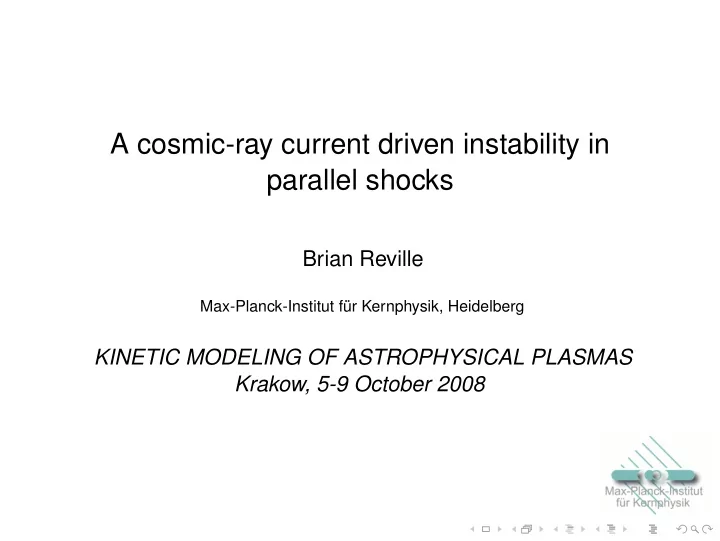

A cosmic-ray current driven instability in parallel shocks Brian Reville Max-Planck-Institut für Kernphysik, Heidelberg KINETIC MODELING OF ASTROPHYSICAL PLASMAS Krakow, 5-9 October 2008
Cosmic-ray current driven instability ◮ We consider the region upstream of a quasi-pll shock ◮ 3-component plasma ◮ relativistic beam of protons ( Γ b ) along zeroth order field ◮ thermal electron/proton distribution k b T / mc 2 = Θ ≪ Γ b ◮ linear dispersion relation for circularly polarised waves ◮ plasma susceptibility: 2 ω ′ 2 ω ′ ω ′ ω ′ ω 2 ǫω c + ω ′ + c 2 ω 2 p ω pb pb � c 2 k 2 − ω 2 � � � ω 2 χ ≈ u 2 − + ⊥ v 2 ǫω 3 ǫω c p c A ω Θ j , ck Θ j ≪ | ω cj |
Cosmic-ray current driven instability ◮ Neglecting thermal effects, and provided Γ b β 2 ( n b / n p )( ω pp /ω cp ) 2 ≫ 1 maximum growth rate of Im ( ω ) = 1 n b β b ω pp 2 n p Same result as Bell 2004 ◮ Including thermal effects, if Θ p ≫ v A / c √ � 1 � 2 � 2 � � 2 β 2 3 3 � ω pp 3 � n b 3 � v A 3 b Im ( ω ) = ω c u 2 2 n p c ω c � � ⊥ ◮ May provide saturation mechanism in relativistic plasmas
Cosmic-ray current driven instability e.g., v A = 2 × 10 − 5 , Γ b = 10, n b / n p = 1 / 10, ǫ = − 1, ǫ = + 1 ω ˜ ω ˜ log ˜ log ˜ k k Θ = 1 / 10 Θ = 1 / 1000 cf. BR, Kirk & Duffy 2006, PPCF
Cosmic-ray current driven instability ◮ saturation when currents associated with waves: | k × B | ≈ 4 π n cr e β ◮ k ∼ 1 / r g - saturated field energy B 2 8 π = 1 w 2 n cr Γ b m p c 2 ◮ Entire energy of the beam goes into magnetic field production ◮ How do we include this in acceleration models?
Cosmic-ray modified shocks ◮ Particles escape beyond some boundary ◮ escaping particles drive magnetic field growth
Steady-state solutions ◮ coupled hydrodynamic - kinetic equations ∂ f ∂ t + ∂ � uf − κ ( x , p ) ∂ f � = ∂ � p 3 f ∂ u � ∂ p 3 ∂ x ∂ x ∂ x L esc = κ ( p ∗ ) p ∗ = 10 5 , e.g. u 0 10 R=9.5 R=2.2 R=1.1 1 p 4 f 0 0.1 0.01 0.001 0.1 1 10 100 1000 10000 100000 1e+06 p/mc
Injection efficiency ν − R diagram 1 M=10 50 100 ν 500 0.1 0.01 1 10 100 R u 0 = 5000km s − 1 , n 0 = 1 cm − 3 , p ∗ = 10 3 mc 2 ν = 4 π p 4 0 f 0 ( p 0 ) , 3 ρ 0 u 2 0
Maximum momentum ◮ what is the location of escape boundary - transition zone from weak to strong turbulence ◮ L esc = κ ( p ∗ ) / u 0 determines maximum confined energy ◮ diffusive current at escape boundary drives nonresonant instability � ∞ κ ∂ f ∂ x p 2 d p j cr ( − L esc ) = − 4 π e p 0 ◮ How do we determine L esc in a self-consistant manner? ◮ Calculate CR flux (and p ∗ ) from numerical SS solution ◮ Transition zone determined from condition L adv ≡ u sh / Γ max ∼ L esc
Maximum momentum 4 10 5 10 4 10 3 10 2 3.5 L adv L esc 3 2.5 2 1.5 1 0.5 0 0.01 0.1 ν BR, Kirk & Duffy, ApJ submitted ◮ Maximum energy can be calculated as a function of injection parameter
Summary ◮ Efficient acceleration of particles at collisionless shocks connected with magnetic field amplification ◮ nonresonant mode (Bell 2004) appears to be of greatest importance in efficient cosmic-ray accelerating shocks ◮ reduced diffusion coefficients leads to more rapid acceleration ◮ field amplification incorporated using free escape boundary L esc ◮ maximum energy determined by boundary position - calculated self-consistently ◮ system is self-organising - maximum energy function of injection
Recommend
More recommend